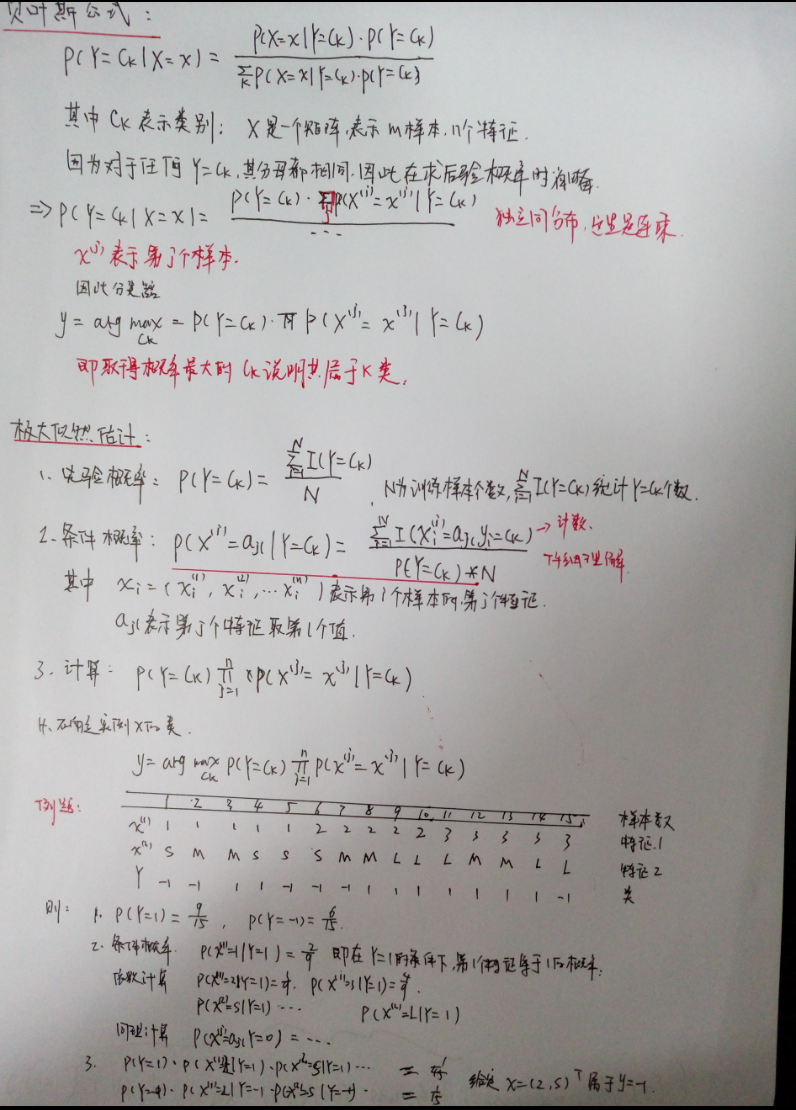贝叶斯决策理论
在机器学习中,朴素贝叶斯是基于贝叶斯决策 的一种简单形式,下面给出贝叶斯的基本公式,也是最重要的公式:
- 其中X是一个m*n的矩阵,m为他的样本数,n为特征的个数,即我们要求的是:在已知的样本情况下的条件概率。
)表示的是条件概率
)为先验概率
为什么需要朴素贝叶斯
这里有两个原因:
- 由统计学知识,如果每个特征需要N个样本,那么对于10个特征需要
个样本,这个数据无疑是非常大的,会随着特征的增大而迅速的增大。如果特征之间独立,那么样本数就可以减少到10*N,所谓的独立及时每个特征与其他的特征没有关系,当然这个假设很强,因为我们知道实际中是很难的。
- 因为独立同分布,因此在计算条件概率的时,可以避免了求联合概率,因此可以写成:
下面给算法的实现过程(打公式太难,不喜勿喷):
上述算法的修正
1. 最后概率可能为0
在进行分类是,多个概率乘积得到类别,但是如果有一个概率为0,则最后的结果为0,因此未来避免未出现的属性值,在估计概率时同城要进行“平滑”, 常用的是“拉普拉斯修正”(Laplacian correction),具体来说,在计算)的时候,将分子加1,分母加上类别数N.同样在计算
)的时候在分子加1,分母加上Ni,其表示第i个属性的可能的取值数。
2. 值过小可能会溢出
在实际中对概率取对数的形式,可以防止相乘是溢出。
垃圾邮件分类
在email/spam文件夹中有25封垃圾邮件,在email/ham中有25封正常邮件,将其进行垃圾邮件分类。
分词
首先遇到的问题是怎样把一封邮件进行分词,即将其划分成一个个单词的形式。可以想到用正则表达式,关于正则表达式可以参考网上的资料,这里给出python的程序,实现怎样将一个长的字符冲进行分词的操作。
def textParse(bigString):
import re #导入正则表达式的库
listOfTokens=re.split(r'\W*',bigString) #返回列表
return [tok.lower() for tok in listOfTokens if len(tok)>2]示例:
#见最后的总程序
#可见它将一封邮件进行了分词
[yqtao@localhost ml]$ python bayes.py
['peter', 'with', 'jose', 'out', 'town', 'you', 'want', 'meet', 'once', 'while', 'keep', 'things', 'going', 'and', 'some', 'interesting', 'stuff', 'let', 'know', 'eugene']这里的re.split(r'\W*',bigString),表示以除了数字,字母和下划线的符合进行划分,return 的是一个列表推到式生成的列表,其中将单词长度小于等于2的过滤掉,并且将其变成小写字母。
生成词汇表
将所有的邮件进行分词后生成一个dataSet,然后生成一个词汇表,这个词汇表是一个集合,即每个单词只出现一次,词汇表是一个列表形式如:
[“cute”,”love”,help”,garbage”,”quit”…]
def createVocabList(dataSet):
vocabSet=set([])
for docment in dataSet:
vocabSet=vocabSet| set(docment) #union of tow sets
return list(vocabSet) #convet if to list 生成词向量
每一封邮件的词汇都存在了词汇表中,因此可以将每一封邮件生成一个词向量,存在几个则为几,不存在为0,例如:[“love”,”garbage”],则他的词向量为
[0,1,0,1,0,…],其位置是与词汇表所对应的,因此词向量的维度与词汇表相同。
#vocablist为词汇表,inputSet为输入的邮件
def bagOfWords2Vec(vocabList,inputSet):
returnVec=[0]*len(vocabList) #他的大小与词向量一样
for word in inputSet:
if word in vocabList:
returnVec[vocabList.index(word)]+=1 #查找单词的索引
else: print ("the word is not in my vocabulry")
return returnVec训练算法
这一步是算法的核心,要计算:
1. 先验概率
2. 计算),
) 这里0表示正常邮件,1表示垃圾邮件。
这里需要重点的理解是如何计算第二步的,例如,),表示在垃圾邮件的条件下第i个特征的概率,首先先将所有的类别为1的词向量相加,可以得到每个特征的个数,因此在除以在类别1的单词总数就是在垃圾邮件中每个单词的概率了。注意,这里所说的特征即词汇的每一个单词。
python程序如下:
#这里的trainMat是训练样本的词向量,其是一个矩阵,他的每一行为一个邮件的词向量
#trainGategory为与trainMat对应的类别,值为0,1表示正常,垃圾
def train(trainMat,trainGategory):
numTrain=len(trainMat)
numWords=len(trainMat[0]) #is vocabulry length
pAbusive=sum(trainGategory)/float(numTrain)
p0Num=ones(numWords);p1Num=ones(numWords)
p0Denom=2.0;p1Denom=2.0
for i in range(numTrain):
if trainGategory[i] == 1:
p1Num += trainMat[i] #统计类1中每个单词的个数
p1Denom += sum(trainMat[i]) #类1的单词总数
else:
p0Num += trainMat[i]
p0Denom +=sum(trainMat[i])
p1Vec=log(p1Num/p1Denom) #类1中每个单词的概率
p0Vec=log(p0Num/p0Denom)
return p0Vec,p1Vec,pAbusive处理数据验证过程
这里首先将50封邮件读进docList列表中,然后生成一个词汇表包含所有的单词,接下来使用交叉验证,随机的选择10个样本进行测试,40个样本进行训练。
#spam email classfy
def spamTest():
fullTest=[];docList=[];classList=[]
for i in range(1,26): #it only 25 doc in every class
wordList=textParse(open('email/spam/%d.txt' % i).read())
docList.append(wordList)
fullTest.extend(wordList)
classList.append(1)
wordList=textParse(open('email/ham/%d.txt' % i).read())
docList.append(wordList)
fullTest.extend(wordList)
classList.append(0)
vocabList=createVocabList(docList) # create vocabulry
trainSet=range(50);testSet=[]
#choose 10 sample to test ,it index of trainMat
for i in range(10):
randIndex=int(random.uniform(0,len(trainSet)))#num in 0-49
testSet.append(trainSet[randIndex])
del(trainSet[randIndex])
trainMat=[];trainClass=[]
for docIndex in trainSet:
trainMat.append(bagOfWords2Vec(vocabList,docList[docIndex]))
trainClass.append(classList[docIndex])
p0,p1,pSpam=train(array(trainMat),array(trainClass))
errCount=0
for docIndex in testSet:
wordVec=bagOfWords2Vec(vocabList,docList[docIndex])
if classfy(array(wordVec),p0,p1,pSpam) != classList[docIndex]:
errCount +=1
print ("classfication error"), docList[docIndex]
print ("the error rate is ") , float(errCount)/len(testSet)完整的代码如下:
from numpy import *
#create a vocablist of set ,word can only exit once
def createVocabList(dataSet):
vocabSet=set([])
for docment in dataSet:
vocabSet=vocabSet| set(docment) #union of tow sets
return list(vocabSet) #convet if to list
def bagOfWords2Vec(vocabList,inputSet):
returnVec=[0]*len(vocabList)
for word in inputSet:
if word in vocabList:
returnVec[vocabList.index(word)]+=1
else: print ("the word is not in my vocabulry")
return returnVec
# tranin algorithm
# the p1Num is mean claclualte in 1 class evrey word contain weight
def train(trainMat,trainGategory):
numTrain=len(trainMat)
numWords=len(trainMat[0]) #is vocabulry length
pAbusive=sum(trainGategory)/float(numTrain)
p0Num=ones(numWords);p1Num=ones(numWords)
p0Denom=2.0;p1Denom=2.0
for i in range(numTrain):
if trainGategory[i] == 1:
p1Num += trainMat[i]
p1Denom += sum(trainMat[i])
else:
p0Num += trainMat[i]
p0Denom +=sum(trainMat[i])
p1Vec=log(p1Num/p1Denom)
p0Vec=log(p0Num/p0Denom)
return p0Vec,p1Vec,pAbusive
# classfy funtion
def classfy(vec2classfy,p0Vec,p1Vec,pClass1):
p1=sum(vec2classfy*p1Vec)+log(pClass1)
p0=sum(vec2classfy*p0Vec)+log(1-pClass1)
if p1 > p0:
return 1;
else:
return 0
# split the big string
def textParse(bigString):
import re
listOfTokens=re.split(r'\W*',bigString)
return [tok.lower() for tok in listOfTokens if len(tok)>2]
#spam email classfy
def spamTest():
fullTest=[];docList=[];classList=[]
for i in range(1,26): #it only 25 doc in every class
wordList=textParse(open('email/spam/%d.txt' % i).read())
docList.append(wordList)
fullTest.extend(wordList)
classList.append(1)
wordList=textParse(open('email/ham/%d.txt' % i).read())
docList.append(wordList)
fullTest.extend(wordList)
classList.append(0)
vocabList=createVocabList(docList) # create vocabulry
trainSet=range(50);testSet=[]
#choose 10 sample to test ,it index of trainMat
for i in range(10):
randIndex=int(random.uniform(0,len(trainSet)))#num in 0-49
testSet.append(trainSet[randIndex])
del(trainSet[randIndex])
trainMat=[];trainClass=[]
for docIndex in trainSet:
trainMat.append(bagOfWords2Vec(vocabList,docList[docIndex]))
trainClass.append(classList[docIndex])
p0,p1,pSpam=train(array(trainMat),array(trainClass))
errCount=0
for docIndex in testSet:
wordVec=bagOfWords2Vec(vocabList,docList[docIndex])
if classfy(array(wordVec),p0,p1,pSpam) != classList[docIndex]:
errCount +=1
print ("classfication error"), docList[docIndex]
print ("the error rate is ") , float(errCount)/len(testSet)
if __name__ == '__main__':
#下面的为了演示分词的,可注释
#listWord=textParse(open('email/ham/1.txt').read())
spamTest()运行与测试:直接python bayes.py运行,结果如下:
[yqtao@localhost ml]$ python bayes.py
classfication error ['home', 'based', 'business', 'opportunity', 'knocking', 'your', 'door', 'don', 'rude', 'and', 'let', 'this', 'chance', 'you', 'can', 'earn', 'great', 'income', 'and', 'find', 'your', 'financial', 'life', 'transformed', 'learn', 'more', 'here', 'your', 'success', 'work', 'from', 'home', 'finder', 'experts']
[yqtao@localhost ml]$ python bayes.py
the error rate is 0.0
[yqtao@localhost ml]$ python bayes.py
the error rate is 0.0
[yqtao@localhost ml]$ python bayes.py
the error rate is 0.0
[yqtao@localhost ml]$ python bayes.py
classfication error ['scifinance', 'now', 'automatically', 'generates', 'gpu', 'enabled', 'pricing', 'risk', 'model', 'source', 'code', 'that', 'runs', '300x', 'faster', 'than', 'serial', 'code', 'using', 'new', 'nvidia', 'fermi', 'class', 'tesla', 'series', 'gpu', 'scifinance', 'derivatives', 'pricing', 'and', 'risk', 'model', 'development', 'tool', 'that', 'automatically', 'generates', 'and', 'gpu', 'enabled', 'source', 'code', 'from', 'concise', 'high', 'level', 'model', 'specifications', 'parallel', 'computing', 'cuda', 'programming', 'expertise', 'required', 'scifinance', 'automatic', 'gpu', 'enabled', 'monte', 'carlo', 'pricing', 'model', 'source', 'code', 'generation', 'capabilities', 'have', 'been', 'significantly', 'extended', 'the', 'latest', 'release', 'this', 'includes']
the error rate is 0.1因为是随机选择的样本,可以运行10次取平均值,可以观察到,测试效果还不错。还有一点要注意,这里一直出现的是将垃圾邮件误判为正常邮件,这会比将正常的误判为垃圾邮件要好。
完整的代码和数据在我的github:
https://github.com/yqtaowhu/MachineLearning
参考资料:
- 《统计学习方法》李航著
- 《机器学习》周志华著
- 《机器学习实战》Peter Harrington























 1万+
1万+











 被折叠的 条评论
为什么被折叠?
被折叠的 条评论
为什么被折叠?








